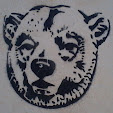Not quite up to Peter Carl's famous jewelled
'Faberge' eggs of Imperial Russia's Czars, but pretty nevertheless. My favorite
type of decorative object - if I have just one! - as cloisonné tends to very
rich colours due to the depth of the enamel - powdered glass - while the little
trails of metal always give it an outlined, cartoon-like, quality.
Cloisonné is a method of enameling,
especially curved objects, by reducing the area to be covered by breaking it
into lots of little areas or chambers, using thin metal wire or ribbon which is
then soldered into place.
The chambers are then filled with enamel
powder (or on something as curved as this; a paste) and when fired it won't flow
beyond the 'walls' of the chamber (which on these eggs; is formed of fine brass
ribbon) due to a type of 'water tention' keeping them within their bounds.
From a distance we can see it's a mass of
blue chrysanthemums (a typical oriental or 'chinoiserie' motif) with the odd
green leaf sprinkled among the blue.
This one is a mass of butterflies or moths
flying hither and thither! I don't know the significance of the holes both
these eggs have, but suspect it's related to the firing; as in somewhere to
hang the egg in the oven without leaving a mark in the enamel? It may be for
more straightforward, decorative 'hanging' purposes?
And . . . is that the Cherilea hen we looked at the other day? It makes a good painting guide!






2 comments:
I started a collection of Papier mache coloured eggs years back..still got ém somewhere.
Get them on the Blog! You've got a year to find them...now you've missed this boat!!
H ;-)
Post a Comment